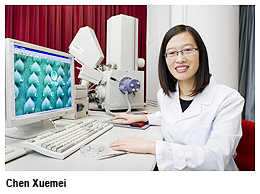Newly developed bio-inspired materials significantly improve electronic cooling
Bio-inspired materials newly developed by City University of Hong Kong (CityU) can significantly improve the efficiency of electronic cooling, opening up the possibilities for shrinking the size of electronic products even further.
The drive for smaller, faster and cheaper electronic chips leads to increased heat dissipation problems. Removing the heat efficiently from a limited space within electronic products has therefore become a major concern in the industry.
A promising solution to this problem has been developed by Chen Xuemei, a second-year PhD student at CityU’s Department of Mechanical and Biomedical Engineering. Under the supervision of Dr Wang Zuankai, Assistant Professor from the same department at CityU, and Dr Yao Shuhuai, Assistant Professor from the Department of Mechanical Engineering at the Hong Kong University of Science and Technology (HKUST), Chen Xuemei has developed a unique nanograssed micro-pyramid architecture.
With a layer of nanograss added to the pyramid’s upper part and between the sides, its surface becomes globally superhydrophobic. On the contrary, the lower part of the pyramid is relatively wettable, which favours droplet nucleation and growth. The vapour produced from the heat of the electronic chips condenses into a spherical-shaped liquid. The droplets in the wettable patches grow much faster, coalesce with neighbouring droplets and depart from the surface spontaneously. As the heat is removed along with the outgoing droplets, a faster and more efficient way of cooling can be achieved.
This new nanograssed micro-pyramid architecture enhances the heat transfer coefficient by 100 to 200%. It not only significantly reduces energy consumption for cooling, but also makes it possible to shrink the size of electronic products further.
Chen Xuemei said her work was inspired by the intricate structures of lotus leaves and beetles. “Both of them have a nano-architectural surface which is superhydrophobic. However, in terms of heat transfer, our newly developed materials are far better than those in nature,” she said.
The new structure can be widely applied to electronic products that have chips, such as computers and mobile phones, as well as electronic appliances that have heat pipes like air conditioners and refrigerators, she said. All you need to add nanograss lawns to the surface of materials is to modify the superficial structure of the materials using instruments commonly employed in the microelectronics industry. No extra manufacturing costs will be incurred. In addition, the technology can be used for water-gathering systems in dry places around the world.
Chen Xuemei completed her bachelor’s and MPhil degrees at the University of Jinan. CityU’s well-qualified faculty members and excellent teaching and learning facilities are the key to her research achievements, she said.
“CityU has strong research teams, state-of-the-art laboratories and a positive study atmosphere. I can use the equipment and facilities in different departments and get advice from patient technicians to deal with difficult technical problems. This helps me focus on my professional research area and lay a good foundation for my future studies,” she added.
With the support of a CityU Strategy Research Grant, Chen Xuemei plans to develop nano structures for other metals and conduct a series of experiments to find out the size of condensed droplets that will be spontaneously removed, the density of droplet nucleation and the relationship with their structures. She is also considering a patent application and collaboration with the industry.
Chen Xuemei is the first author of the research paper, which was published recently as the cover story in Advanced Functional Materials, the top-tier journal in materials science..
The co-authors of the paper include Dr Wang, Dr Yao, Professor Nikhil Koratkar at Rensselaer Polytechnic Institute, Dr Hua Meng at CityU’s Department of Mechanical and Biomedical Engineering, and Wu Jun and Ma Ruiyuan from HKUST.


